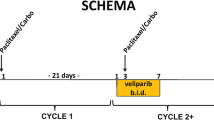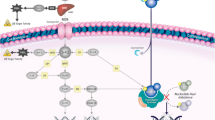Abstract
Purpose. Combinations of vinorelbine (VRB) and drugs targeting thymidylate synthase (TS) such as 5-fluorouracil (5-FU) have proven clinical efficacy in the management of advanced breast cancer. Raltitrexed (RTX) is a recent TS inhibitor which shows advantages over 5-FU in terms of a lower incidence of toxicity along with a simpler administration schedule. We conducted a phase I trial of the VRB-RTX combination in 12 patients with advanced breast cancer.
Materials and methods. Most of the patients were refractory to taxane-anthracycline combination therapy. Their median age was 51 years (range 33–70 years). RTX was given on day 1 and VRB on days 1 and 5 on a 3-week cycle. Three dose levels were initially planned with VRB and RTX increasing from 22.5 to 25 mg/m2 and from 2.5 to 3 mg/m2, respectively.
Results. From a total of 50 cycles (mean 4 cycles per patient, range 1–11), the maximal tolerated dose (MTD) was reached at VRB 25 mg/m2 and RTX 3 mg/m2 with grade 3-4 neutropenia as the dose-limiting toxicity (7/16 cycles and 3/5 patients at the MTD). Nine pretreated patients were evaluable for treatment efficacy and three of these showed an objective response (one complete response, two partial responses; mean duration 26 weeks, range 17–38 weeks). Pharmacokinetic follow-up was done for both drugs (RTX by LC-MS-MS and VRB by HPLC-UV detection). There was no interaction between RTX and VRB pharmacokinetics since the VRB AUC was not significantly modified between day 1 and day 5. There was no relationship between RTX AUC and hematological toxicity. In contrast, there was a highly significant relationship between the mean VRB AUC (days 1–5) and the absolute neutrophil count decrease (Emax model, Hill constant=4.38±2.59, EC50=508±53.2 µg·h/l, r=0.75, P=0.0013). A similar relationship was noted for the platelet decrease but at the limit of statistical significance.
Conclusions. The VRB-RTX combination appears to be a valuable treatment option in second-line treatment of advanced breast cancer. It is deliverable on an outpatient basis, shows an acceptable toxicity profile potentially manageable by VRB pharmacokinetic follow-up, and has promising antitumor activity in taxane-anthracycline-refractory patients. The recommended dose for further studies is VRB 22.5 mg/m2 and RTX 3 mg/m2.
Similar content being viewed by others
Author information
Authors and Affiliations
Additional information
Electronic Publication
Rights and permissions
About this article
Cite this article
Ferrero, JM., Chamorey, E., Magné, N. et al. The raltitrexed-vinorelbine combination: a phase I pharmacokinetic and pharmacodynamic trial in advanced breast cancer. Cancer Chemother Pharmacol 50, 459–464 (2002). https://doi.org/10.1007/s00280-002-0519-2
Received:
Accepted:
Issue Date:
DOI: https://doi.org/10.1007/s00280-002-0519-2




